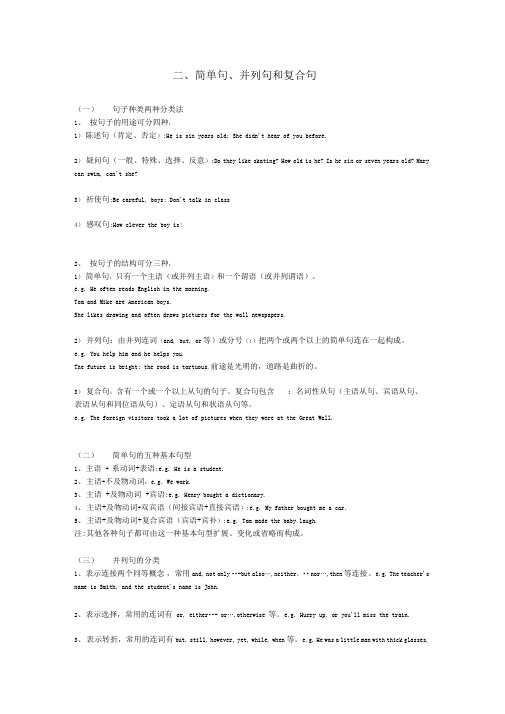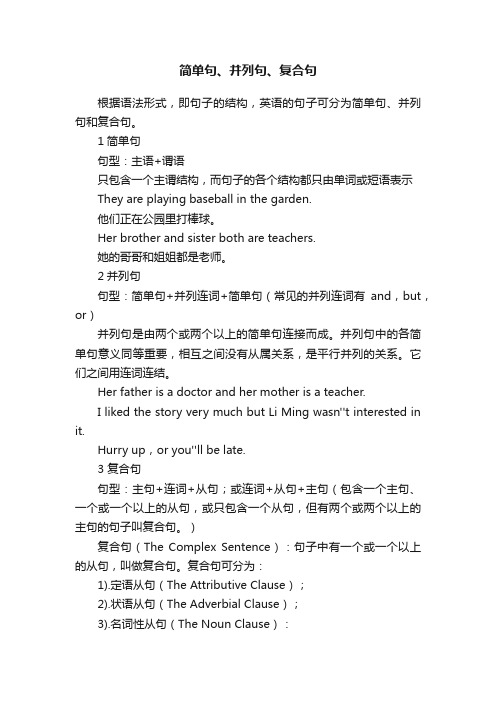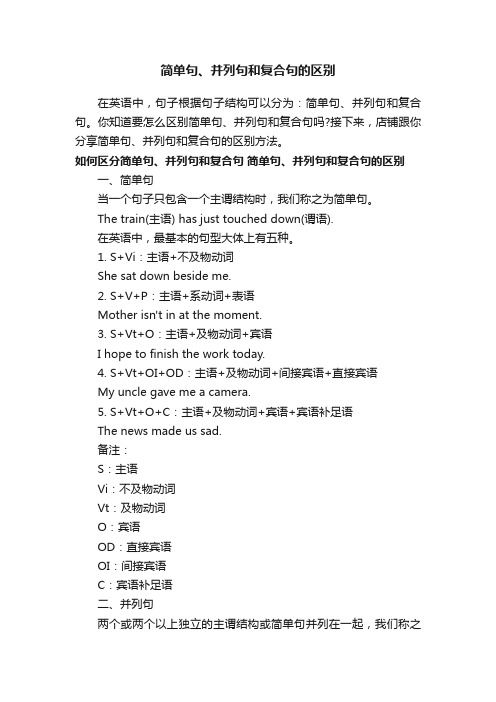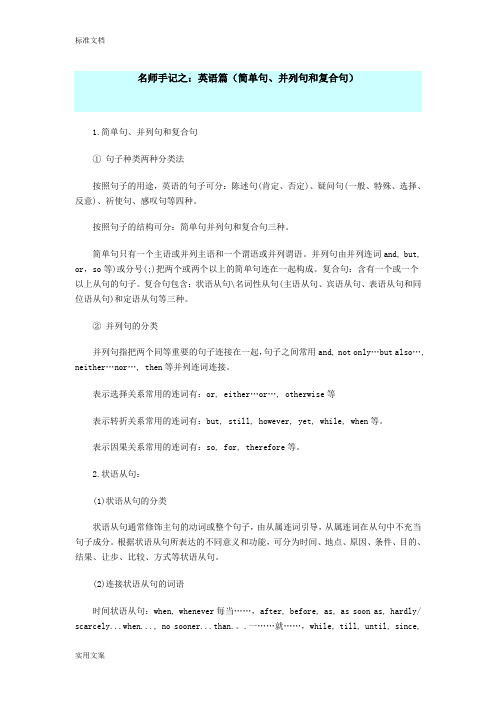英语简单句、并列句、复合句
区分英语简单句-并列句-复合句

复合句:有一个主句和若干个从句组成
1. What I want to explain is this.
2.We should never pretend to know what we don’t know. 3.That’s exactly what I am planning to do.
4.We expressed the hope that they would come and visit china again. 5.He asked me to stay where I was.
2.Not only…but also…的用法 Not only was he himself interested in the subject, but( also) his students began to show interest in it. Not only you but also I am wrong.
for, so 连接并列句表示因果关系
for引导的分句是对前面的句子加以解释或推断, 一般用逗号隔开.引导的句子不用于句首. Someone is coming , for the dog is barking .
He shook his head, for he thought differently.
4. We thought there were 35 students in the dining hall, ___ A , in fact, there were 40. A.while B. whether C. what D. which 5. The cost of living in Glasgow is among the lowest in Britain, ___ D the quality of life is probably one of the highest. A.since B. when C. as D. while
简单句、并列句和复合句包括五大句型

二、简单句、并列句和复合句(一)句子种类两种分类法1、按句子的用途可分四种:1)陈述句(肯定、否定):He is six years old; She didn't hear of you before.2)疑问句(一般、特殊、选择、反意):Do they like skating? How old is he? Is he six or seven years old? Mary can swim, can't she?3)祈使句:Be careful, boys; Don't talk in class4)感叹句:How clever the boy is!2、按句子的结构可分三种:1)简单句:只有一个主语(或并列主语)和一个谓语(或并列谓语)。
e.g. He often reads English in the morning.Tom and Mike are American boys.She likes drawing and often draws pictures for the wall newspapers.2)并列句:由并列连词(and, but, or等)或分号(;)把两个或两个以上的简单句连在一起构成。
e.g. You help him and he helps you.The future is bright; the road is tortuous.前途是光明的,道路是曲折的。
3)复合句:含有一个或一个以上从句的句子。
复合句包含:名词性从句(主语从句、宾语从句、表语从句和同位语从句)、定语从句和状语从句等。
e.g. The foreign visitors took a lot of pictures when they were at the Great Wall.(二)简单句的五种基本句型1、主语+ 系动词+表语:e.g. He is a student.2、主语+不及物动词:e.g. We work.3、主语 +及物动词 +宾语:e.g. Henry bought a dictionary.4、主语+及物动词+双宾语(间接宾语+直接宾语):e.g. My father bought me a car.5、主语+及物动词+复合宾语(宾语+宾补):e.g. Tom made the baby laugh.注:其他各种句子都可由这一种基本句型扩展、变化或省略而构成。
简单句 并列句 复合句

1. 陈述句(Declarative Sentences)
用来说明一个事实或陈述一种看法。例如: 1) Light travels faster than sound.
光比声传播速度快。(说明事实) 2) The film is rather boring.
这部电影很乏味。(说明看法)
要特别注意陈述句的否定结构
6. 状语 ( Adverbial )
常指修饰动词、形容词或副词的成分,修饰动词时 表示动作发生的时间、地点、目的或方式等;修饰 形容词或副词时表示它们的程度等。状语常由副词、 介词短语、动词不定式或分词短语等充当。 例如: 1. The miners work very hard. 2. She often helps Mike at school. 3. Hearing the news, he couldn’t help jumping.
3. 宾语 ( Object )
常指及物动词或介词后面使之意思完整的词或短语。 常由名词、代词、动词不定式或动名词短语等充当。 例如: 1. She has finished doing the experiment. 2. We like English and are good at it.
4. 表语 ( Predicative )
5)主 + 动 + 间宾 + 直宾 例如: My mother made me a new dress. 我母亲给我做了一件新衣裳。
IV. 并列句的常用连词
1. 我们常用并列连词and, not only…but also…等 连接联合并列句,用not only…but also… 时, 前面一句要用部分倒装 。例如: 1)Use your head, and you’ll find a way. 2)Not only does he want to come, but the students also need him.
简单句、并列句、复合句

简单句、并列句、复合句根据语法形式,即句子的结构,英语的句子可分为简单句、并列句和复合句。
1简单句句型:主语+谓语只包含一个主谓结构,而句子的各个结构都只由单词或短语表示They are playing baseball in the garden.他们正在公园里打棒球。
Her brother and sister both are teachers.她的哥哥和姐姐都是老师。
2并列句句型:简单句+并列连词+简单句(常见的并列连词有and,but,or)并列句是由两个或两个以上的简单句连接而成。
并列句中的各简单句意义同等重要,相互之间没有从属关系,是平行并列的关系。
它们之间用连词连结。
Her father is a doctor and her mother is a teacher.I liked the story very much but Li Ming wasn''t interested in it.Hurry up,or you''ll be late.3 复合句句型:主句+连词+从句;或连词+从句+主句(包含一个主句、一个或一个以上的从句,或只包含一个从句,但有两个或两个以上的主句的句子叫复合句。
)复合句(The Complex Sentence):句子中有一个或一个以上的从句,叫做复合句。
复合句可分为:1).定语从句(The Attributive Clause);2).状语从句(The Adverbial Clause);3).名词性从句(The Noun Clause):一、定语从句定语从句的定义定语从句在句子中作定语,用来修饰一个名词、名词词组或者代词。
先行词和引导词被修饰的名词、名词词组或代词叫做先行词;在先行词和定语从句之间起连接作用的词叫做引导词。
引导词分为“关系代词”和“关系副词”。
关系代词和关系副词关系代词有:who, whom, whose, that, which, as。
简单句、并列句和复合句的区别

简单句、并列句和复合句的区别在英语中,句子根据句子结构可以分为:简单句、并列句和复合句。
你知道要怎么区别简单句、并列句和复合句吗?接下来,店铺跟你分享简单句、并列句和复合句的区别方法。
如何区分简单句、并列句和复合句简单句、并列句和复合句的区别一、简单句当一个句子只包含一个主谓结构时,我们称之为简单句。
The train(主语) has just touched down(谓语).在英语中,最基本的句型大体上有五种。
1. S+Vi:主语+不及物动词She sat down beside me.2. S+V+P:主语+系动词+表语Mother isn't in at the moment.3. S+Vt+O:主语+及物动词+宾语I hope to finish the work today.4. S+Vt+OI+OD:主语+及物动词+间接宾语+直接宾语My uncle gave me a camera.5. S+Vt+O+C:主语+及物动词+宾语+宾语补足语The news made us sad.备注:S:主语Vi:不及物动词Vt:及物动词O:宾语OD:直接宾语OI:间接宾语C:宾语补足语二、并列句两个或两个以上独立的主谓结构或简单句并列在一起,我们称之为并列句。
各个简单句间是平行并列的关系,而非从属关系。
并列句的各个分句间可用逗号、分号、起连接作用的副词或并列连接词来连接。
1. 能连接并列句的连词and(和,又),but(但是),for(因为),however(然而),or(或者),so(所以,因而),while(然而),yet(然而)2. 能连接并列句的复合连词or else(否则,要不然),either...or...(要么···,要么···;或者···,或者···),neither...nor...(既不···,也不···),not only...but also(不仅···,而且···)3. 能连接并列句的副词besides(而且,还有),hence(因此),otherwise(否则,要不然),then(然后,于是),therefore(因此,所以),thus(因而,从而) 根据并列分句之间的不同关系,并列句则可以分为以下四种。
英语句子类型简单句并列句复合句

定语从句
英语中的定语是一个词时,放在被修饰词的前面, ①a beautiful girl ②a lovely boy (形容词作定语)
定语是两个以上的词组、短语或从句则放在被修饰词的后面, 如: ③She is the girl in red. (介词短语作定语) ④The lady carried a bag full of money. (形容词短语作定语) ⑤He is the man who you are looking for. (定语从句作定语)
先行词和关系词的关系
1.A plane is a machine that can fly.
a machine = that
2.The boy who broke the window is called Tom.
the boy = who 关系代词实际上是先行词的复指
3.The boy whose parents are dead was brought up by his grandfather. the boy 's =whose
There existed many dinosaurs.
简单句的基本词序
主语
动词部分 宾语
状语
(谓语)
(方式 /地点/时间)
I
boay.
The children ran
home.
We
ate
our meal
in silence.
The car
stopped
suddenly.
关系词whose 实际上是先行词的所有格
4.The school where I study is far from my home.
简单句-并列句-复合句

简单句-并列句-复合句(总3页)--本页仅作为文档封面,使用时请直接删除即可----内页可以根据需求调整合适字体及大小--简单句、并列句和复合句一句子可以分为简单句、并列句和复合句:1) 简单句:有时句子虽长, 但只有一个主谓结构, 仍是简单句, 例如:Yesterday we went to an exhibition on the life and work of Lenin, the great revolutionary leader of the working class.有时一个句子有两个(或两个以上)并列的主语或谓语, 也仍然是简单句There he was a leader of the student movement and took an active part in revolutionary work. Both the teachers and the students were very active in physical labour.Comrade Yang and I often study together and help each other.2) 并列句:一个句子如果包含两个或更多的互不依从的主谓结构, 就称为并列句。
He was always close to the people, and the people loved him.I didn't make any mistakes in the test, but my handwriting was poor.Some are walking by the lake, others are sitting on the benches and chatting.并列的各个部分(即各个主谓结构)称为分句。
各个分句用并列连词(如 and, but 等)连接;在上下文紧密联系的情况下也可不用连词, 而以逗号隔开(如上面第三句)。
英语句子类型(简单句、并列句、复合句)

并列句
• 3.表示选择关系,常见连词有or,not...but(不是……而 是……),either...or...(要么……要么……)等。 • ①Hurry up, or we'll be late. • ②Either you come to my home or I get to yours.
放在名词或代词后面,由关系代词或关系副词引导的修饰该 名词或代词的从句叫定语从句。被修饰的名词或代词叫先行 词。
Harry Porter is a boy who has magic power.
先行词 关系词
关系代词
定语从句 关系副词 where, when, why
that,which, who, whom, whose
简单句的基本词序
主语 动词部分 (谓语) 宾语 状语 (方式 /地点/时间)
I
The children
bought
ran
a hat
yesterday.
home.
We
The car
ate
stopped
our meal
in silence.
suddenly.
并列句
• 由并列连词把两个或两个以上的简单句连接起来的句子叫 并列句。常见分类: • 1.表示同等、平行或承接关系,常用连词有and, both...and...,not only...but also...,neither...nor...,as well as等。 • ①He helps me and he also helps others. • ②She not only gave us a lot of advice, but also helped us to overcome difficulties. • 2.表示转折关系,常用连词有but,however, yet(然而), while(而)等。 • ①He is young, but he works hard. • ②She is tall, while her elder sister is short.
简单句、并列句和复合句

简单句、并列句和复合句句子按结构可分为简单句、并列句和复合句。
复合句中包含宾语从句、状语从句或定语从句等。
◆一简单句简单句就是只包含一个主谓结构的句子,其句式结构主要有五种:①主 + 谓。
He works in a big company. 他在一家大公司工作。
②主 + 系 + 表。
She is a kind girl. 她是一个善良的女孩。
③主 + 谓 + 宾。
Ann eats junk food twice a week .安一周吃两次垃圾食品。
④主 + 谓 + 间宾 + 直宾。
He gave me a pen .他给我一支钢笔。
⑤主 + 谓 + 宾 + 宾补。
He kept me waiting for two hours .他让我等了两小时。
◆二并列句并列句由两个或两个以上的简单句连接而成。
并列句中的各简单句同等重要,没有从属关系,是并列的关系,之间用并列连词连接。
1. 表示顺承的并列连词有and / not only …but (also)等。
如:She not only gaveus a lot of advice, butalso helped us to overcome difficulties .他不仅给了我们很多建议,而且还帮助我们克服困难。
2. 表示选择的并列连词有or,either …or …等。
如:Either you or Maria will haveto go .你或玛丽亚得去一趟。
3. 表示转折的并列连词有but,yet,however 等。
如:It is hot in summer here , butit’s not cold in winter .这里夏天热,但冬天不冷。
4. 表示因果关系的并列连词有so,如:He works hard , so he is one of the topstudents in our class .因为他学习努力,所以他是我们班最优秀的学生之一。
英语句子成分及分类:简单句-并列句和复合句

练习一
• 一、指出下列句子划线部分是什么句子成 分:
• 1. The students got on the school bus. • 2. He handed me the newspaper. • 3. I shall answer . What a beautiful Chinese painting! • 5. They went hunting together early in the
(五)宾语补足语
• 英语中有些及物动词,除有一个直接宾语 以外,还要有一个宾语补语,才能使句子 的意义完整。带有宾语补足语的一般句型 为:某些及物动词(如make等+宾语+宾 补)。宾补可由名词、形容词、副词、不 定式、分词、介词短语和从句充当。例如:
1. His father named him Dongming.(名词) 2. They painted their boat white.(形容词) 3. Let the fresh air in.(副词)
• 2、复合谓语:(1)由情态动词或其他助动 词加动词原形构成。如:You may keep the book for two weeks. He has caught a bad cold. (2) 由系动词加表语构成。如:We are students.
(三)表语
• 表语用以说明主语的身份、特征和状态, 它一般位于系动词(如be, become, get, look, grow, turn, seem等)之后。表语一般 由名词、代词、形容词、分词、数词、不 定式、动名词、介词短语、副词及表语从 句表示。例如:
morning.
• 6. His job is to train swimmers. • 7. He took many photos of the palaces in
简单句、并列句、复合句

简单句、并列句、复合句根据语法形式,即句子的结构,英语的句子可分为简单句、并列句和复合句。
1简单句句型:主语+谓语只包含一个主谓结构,而句子的各个结构都只由单词或短语表示They are playing baseball in the garden.他们正在公园里打棒球。
Her brother and sister both are teachers.她的哥哥和姐姐都是老师。
2并列句句型:简单句+并列连词+简单句(常见的并列连词有and,but,or)并列句是由两个或两个以上的简单句连接而成。
并列句中的各简单句意义同等重要,相互之间没有从属关系,是平行并列的关系。
它们之间用连词连结。
Her father is a doctor and her mother is a teacher.I liked the story very much but Li Ming wasn''t interested in it.Hurry up,or you''ll be late.3 复合句句型:主句+连词+从句;或连词+从句+主句(包含一个主句、一个或一个以上的从句,或只包含一个从句,但有两个或两个以上的主句的句子叫复合句。
)复合句(The Complex Sentence):句子中有一个或一个以上的从句,叫做复合句。
复合句可分为:1).定语从句(The Attributive Clause);2).状语从句(The Adverbial Clause);3).名词性从句(The Noun Clause):一、定语从句定语从句的定义定语从句在句子中作定语,用来修饰一个名词、名词词组或者代词。
先行词和引导词被修饰的名词、名词词组或代词叫做先行词;在先行词和定语从句之间起连接作用的词叫做引导词。
引导词分为“关系代词”和“关系副词”。
关系代词和关系副词关系代词有:who, whom, whose, that, which, as。
英语简单句、并列句、复合句

名师手记之:英语篇(简单句、并列句和复合句)1.简单句、并列句和复合句① 句子种类两种分类法按照句子的用途,英语的句子可分:陈述句(肯定、否定)、疑问句(一般、特殊、选择、反意)、祈使句、感叹句等四种。
按照句子的结构可分:简单句并列句和复合句三种。
简单句只有一个主语或并列主语和一个谓语或并列谓语。
并列句由并列连词and, but, or,so等)或分号(;)把两个或两个以上的简单句连在一起构成。
复合句:含有一个或一个以上从句的句子。
复合句包含:状语从句\名词性从句(主语从句、宾语从句、表语从句和同位语从句)和定语从句等三种。
② 并列句的分类并列句指把两个同等重要的句子连接在一起,句子之间常用and, not only…but also…, neither…nor…, then等并列连词连接。
表示选择关系常用的连词有:or, either…or…, otherwise等表示转折关系常用的连词有:but, still, however, yet, while, when等。
表示因果关系常用的连词有:so, for, therefore等。
2.状语从句:(1)状语从句的分类状语从句通常修饰主句的动词或整个句子,由从属连词引导,从属连词在从句中不充当句子成分。
根据状语从句所表达的不同意义和功能,可分为时间、地点、原因、条件、目的、结果、让步、比较、方式等状语从句。
(2)连接状语从句的词语时间状语从句:when, whenever每当……,after, before, as, as soon as, hardly/ scarcely...when..., no sooner...than.。
.一……就……,while, till, until, since,once。
名词词组the first time第一次,last time最后一次,every/each time每次,the next time下次,the next day第二天, the moment, the minute, the second, the instant 一……就……;副词immediately, instantly, directly等也可作连词使用。
简单句、并列句、复合句、并列复合句

For personal use only in study and research; not for commercial use简单句、并列句、复合句、并列复合句文章来源:互联网在前面各讲中所说的肯定句、否定句、各种疑问句、感叹句等,是根据句子的作用来划分的。
今天,我们再学习一种新的分类方法:即根据句子的内部结构,特别是句子与句子之间的关系来划分的方法。
根据句子结构,可以分为三种主要类型:简单句、并列句、复合句,另外还有一种叫并列-复合句子。
要搞懂英语句子结构分类,有一点首先必须明白:即什么是“句子”?句子的概念有两层含义:一是它能表达一个清晰、完整的意思。
反过来讲,只要能表达一个清晰、完整的意思的语言单位,不论是长是短,哪怕是一个单词,也算作是一个句子。
这是从意义方面来说的。
二是句子的结构完整。
所谓“完整”,最核心的是一个句子应该有“主语、谓语”。
也就是说,有主语、有谓语的语言单位就是一个句子。
这就是从句子结构方面来分的,也是从句子语法成份方面来划分的。
我们所讲的简单句、并列句、复合句都是从主语、谓语来判定句子类型的。
如果按照句子的结构分类,英文句子可分为三种类型:简单句(Simple Sentence),并列句(Compound Sentence)和复合句(Complex Sentence)。
一、简单句简单句的定义是:或者只有一个主语,或者只有一个谓语。
为什么说“或者”呢?因为简单句可以只有一个主语,但有几个谓语;或者可以有几个主语,但只有一个谓语。
这样一分,简单句就有三种形式了。
1、只有一个主语、一个谓语,再加上其它成份。
例如:Light travels faster than sound.光比声传播速度快。
The film is not interesting.这部电影没有意思。
Can you finish the work on time?你能按时完成工作吗?2、只有一个主语,但有几个谓语,再加上其它成份。
中考英语简单句并列句复合句考点讲解及练习

简单句、并列句和复合句考点一简单句1.简单句只包含一个主谓结构.2.五种简单句:1)主+谓. He comes at last.2)主+系+表. She is a teacher.The soup tastes nice.3)主+谓+宾. They reached the village.4)主+谓+间宾+直宾. He gave me a pen.5)主+谓+宾+宾补. I find that book very useful.考点二并列句并列句:两个或两个以上的简单句,用连词连接起来;常用的连接词有:1.表示顺承关系的:and, not only…but also不仅….而且….等;She ______ gave us a lot of advice, _______ helped us to overcome difficulties.Linda tried to become an excellent teacher, _____ at last she succeeded.2.表示选择关系和否定条件的有or还是,否则Do you want to leave now ____ would you rather set off laterWear your coat, ____ you’ll catch a cold.3.表示转折关系的有but, yet等;He is young, but he works hard.虽然他年轻,但工作努力;4.表示因果关系的有for, so 等;My leg hurts so I go to see a doctor. 我的腿疼,因此我去看医生;考点三主从复合句:宾语从句1.宾语从句的引导词1引导陈述句用 that在口语和非正式文体中常常省略He tells me that he is going shopping this Sunday.2 引导一般疑问句用if或whether.She asked me if\ whether she could join us. whether…or not3 引导特殊疑问句,要用原来的特殊疑问词;She asked them what they were doing.2.宾语从句的语序:要用陈述句语序;I want to know when the train left.3. 宾语从句的时态1主句是一般现在时,一般将来时或祈使句,宾语从句可根据实际需要选用各种时态;He tells us that he has been able to look after himself.(2)主句是过去时态,宾语从句应使用过去时的相应时态;They said that they had already finished the work.(3)如果宾语从句叙述的是客观事实、真理、自然现象等,不管主句用什么时态,从句都用一般现在时;He said that light travels faster than sound.3. 练习1She asked me, “Will you go to the cinema tomorrow”改为含宾语从句的复合句She asked me______ I ______ go to the cinema the next day.2 How lovely the dog is Can you tell me _____A. where did you get itB. where will you get itC. where you got it3 --- Can you tell me _____ your parents at home--- I often wash clothes and sweep the floor.A.how will you helpB. how you helpC. how will you helpD. howdo you help4 When I was young, my grandfather told me that the sun ______ rise in the east.考点四状语从句一、状语从句在复合句中作状语,修饰主句中的动词、形容词、副词等;1.地点状语从句地点状语从句通常由 where 引导;Put all the things _____they were.A. whereB. whenC. whoseD. which2.时间状语从句主句用将来时,从句用一般现在时时间状语从句的引导词有when, before, after, until, as soon as, since, while, as 等She was cooking when someone knock at the door.What will you do after you finished your homework3.条件状语从句在条件状语从句中,常用的引导词有if, unless等;If it dosen’t rain, I” ll go fishing.They will have a picnic unless it rains next Sunday.4.原因状语从句原因状语从句常用的引导词有because, as, since既然等He didn’t come because he was ill.Since we are students, we should study hard.Because 和so 不能在一个句子中同时使用;5. 结果状语从句结果状语从句主要由so…that…, such…that…引导;It’s so hot that we want to go swimming.That’s such an interesting story that everybody likes it.So… that…与简单句之间的句型转换1)that后的句子是否定句,常用too…to进行转换;He is so young that he can’t go to school. he is too young to go to school.2)that后的句子是肯定句;常用enough to 进行转换;The shirt was so cheap that he bought it. the shirt was cheap enough for him to buy.6.目的状语从句目的状语从句常用的引导词有so that, in order that 等 in order to 简单句Please say it in a loud voice so that everyone can hear it.He works harder in order that he can go to a good college.7. 让步状语从句引导词有though, although, even if, even though尽管等;He often helps others though\ although he is not rich.They will stand by you even if you don’t succeed.Though, although与but 不能同时出现在一个句子中8.比较状语从句比较状语从句由than, as…as…, not as\so… as等引导;比较级He is more outgoing than I.He ran as fast as Mike.二、练习1. It’s quite common in Britain to say “thank you”to the drivers _____ people get off the bus.a. afterb. sincec. untild. when2. The art club is for members only. You can’t go in ____you are a member.a. unlessb. becausec. ifd. though3. Now many parents send their children to foreign countries, _____ they want them to get a better education.a. untilb. thoughc. because4. ---- What would some students like to do after finishing their education---- They would like to start to work_______ they needn’t depend on their parents completely.a. as soon asb. so thatc. befored. while考点五定语从句修饰某一名词或代词的从句叫定语从句;被定语从句修饰的词叫先行词,引导定语从句的词叫关系词关系代词和关系副词;1.关系代词的基本用法The man __________spoke at the meeting is from Hong Kong. 指人作主语The building ___________is being built will be used as a hospital.指物作主语I visited a scientist _______ name is known all over the world. 指人作定语2. 关系代词特殊用法1当关系代词在从句中作主语时,从句的谓语动词要与先行词保持一致;He is one of the boys who ______ like playing football.He is the only one of the boys who________ like playing football.2 通常以下四种情况关系代词只能用that而不能用which.1 先行词为all, much, something, everything, nothing, little, none, the one 等不定代词时2先行词被形容词最高级修饰时;3当先行词被the only, the very, the just等修饰时;4先行词中既有人又有物时;3. 关系副词的基本用法;1 when 在句中作状语,表示时间;2 where 在句中作状语,表示地点;.3 why 在句中作状语,表示原因;He remembers the day _______ he joined the League.This is the reason_______ he is late today.This is the place _______ Lu Xun was born.1. 2011泰安--- _______do you read English newspapers---I read China Daily every day.A. How longB. How soonC. How oftenD. How far2.2011抚州John had a short walk after lunch, _______A. did heB. didn't heC. had heD. hadn't he3.2011宁波--- _______do you have an Art Festival in your school---Once a year.A. How longB. How oftenC. How farD. How soon4.2011安徽省If you want to go to see the movie this evening, so _______I.A. doB. amC. willD. should5.2011长沙 _______tall the girl isA. HowB. HowaC. WhatD. What a6.2011长沙 _______ call me Mimi It's my cat's name.A. NotB. Didn'tC. Doesn'tD. Don't7.2011长沙They went to the park yesterday,_______A. don't theyB. didn't theyC. aren't theyD. can't they8.2011福州---Li Mei usually helps others, _______---Yes, she is kind-hearted.A. does sheB. is sheC. doesn't she9.2011眉山There _______an English party in our school tomorrow evening.A. haveB. will haveC. is going to haveD. will be10. 2011济南--- _______a year does your school have sports meetings---Twice a year.A. How oftenB. How soonC. How longD. How many times11. 2011泰州---I have changed my job.---_______.A. So do IB. So have IC. So I doD. So I have12. 2011济南Mike learns a lot about Internet. And _______.A. I don't, eitherB. so do IC. so am I am, too13. 2011眉山Jim never goes to the movies on Saturday, _______A. does JimB. doesn't JimC. doesn't heD. does he14. 2011玉州You've just finished your listening exam Please getyourself ready for the next part, _______A. shall weB. will youC. do youD. are you15. 2011眉山--- _______the weather like last Monday---It was sunny.A. How wasB. What'sC. What wasD. How is16. 2011潍坊_______great scientist Qian Xuesen isA. HowB. HowaC. WhatD. What a17. 2011眉山--- _______do you visit your grandparents---Once a month.A. How soonB. How longC. How muchD. How often18. 2011内江--- _______ do you speak English so well---Because I practice it with my partner every day.A. WhyB. WhenC. Who19. 2011泉州---We'll go to Qing Yuan Mountain tomorrow. Why _______join us---That's a good idea.A. notB. don'tC. can'tD. didn't20. 2011泉州There is little milk in the glass, _______A. is thereB. isn't thereC. isn't itD. does it21. 2011肇庆The students in Class Two played basketball against ClassOne yesterday,_____A. did theyB. didn't theyC. weren't they22. 2011宁波---What a new computer Can you tell me_______---Just the day before yesterday.A. how much you paid for itB. how much did you pay for itC. when you bought itD. when did you buy it23. 2011泰安---Tom wants to know if you will have a picnic tomorrow.---Yes. But if it _______, we'll play chess instead.A. will rainB. rainedC. is rainingD. rains24. 2011烟台---Do you know this dictionary belongs to---Let me see. Oh, it's_______.A. who does; mineB. who; meC. whose; mineD. who; mine25. 2011杭州Franklin told them all _______to be in Britain again.A. he was how happyB. how happy he wasC. how was he happyD. he was happy how26. 2011湖州---What kind of movies do you like---I like the movies_______ are about Chinese history.A. whoB. whomC. whoseD. that27. 2011丽水---Do you know _______---Sorry, I don't have a watch.A. whose watch this isB. whose watch is thisC. what time it isD. what time is it28. 2011重庆The woman asked the policeman where _______.A. the post office isB. the post office wasC. is the post officeD. was the post office29. 2011泰安---Can you guess_______ the new schoolbag yesterday.----Sorry, I've no idea.A. how much did he pay forB. how much he spentC how much he paid for D. how much did he spend30. 2011杭州Who is the man_______ is reading a book over thereA. thatB. whichC. whoseD. what31. 2011湖州---Do you know_______---Next Sunday.A. what they will doB. where they will doC. when they will come hereD. who they will meet32. 2011长沙---Can you tell me why_______---Because I want to help the people there.A. do you go to Tibet西藏B. did you go to TibetC are you going to Tibet D. you are going to Tibet33. 2011浙江省---Linda, could you tell me _______---He is an actor.A. what he doesB. what does he doC where he works D. where does he work34. 2011福州---Could you tell me _______---Sure. The day after tomorrow.A. when will you leave for the U.S.A.B. when Mr. Lee will comeC when your father returned35. 2011济南He asked me_______.A. who did kick the first goal in the World CupB. when was the A. PEC meeting heldC when China became a member of the WTOD. where will the 2008 Olympics be held36. 2011玉州Jane is one of the students in the class _______ have everbeen to China.A. whoB. whoseC. whichD. whom37. 2011济宁Can you tell me _______after this examA. what you didB. what did you doC. what will you doD. what you will do38. 2011苏州---Can you tell me how many colours _______ in a rainbow---SevenA. there areB. are thereC. they areD. are they39. 2011潍坊I can't understand _______Apple's iPad 2.A. why are they so mad aboutB. why they are so mad aboutC. how are they so mad aboutD. how they are so mad a。
英语句子的分类

英语句子的分类英语句子按其语法结构可以分为简单句、并列句和复合句三种类型。
1. 简单句(Simple Sentence):只有一个主谓结构的句子。
例如:1) Things change.2) Fire and water do not agree.3) He came into the classroom and sit down.2. 并列句(Compound Sentence):包含两个或两个以上互不依从的主谓结构的句子。
并列句的各个分句常用一定的并列连词(coordinating conjunction)(FAN BOYS)、连接副词(conjunctive adverbs)和分号(semicolon)连接在一起。
例如:1) I hate jogging, but I love hiking.2) Fishes must stay in water, or they will die.3) Punctuation is important; therefore, don’t forget to use a comma before the coordinating conjunction in a compound sentence.4) This is the best book I have ever read; it kept me up all night.3. 复合句(Complex Sentence):由一个主句(main clause)和至少一个从句(subordinate clause)构成的句子。
从句须用关联词(connective)引导,来表明与主句的关系。
例如:1) She loves her dog as a mother loves her child.2) Although many people were unknown to each other before, they have got acquainted with each other through e-mail.3) When you go for a job interview, it is important to create a good fist impression.4. 并列复合句(Compound-Complex Sentence),例如:1). Jack, who reads comics, rarely reads novels; however, Tom enjoysnovels.2). While the men worked to strengthen the dam, the rain continued to fall, and the river, which was already well above its normal level, rose higher and higher.。
- 1、下载文档前请自行甄别文档内容的完整性,平台不提供额外的编辑、内容补充、找答案等附加服务。
- 2、"仅部分预览"的文档,不可在线预览部分如存在完整性等问题,可反馈申请退款(可完整预览的文档不适用该条件!)。
- 3、如文档侵犯您的权益,请联系客服反馈,我们会尽快为您处理(人工客服工作时间:9:00-18:30)。
名师手记之:英语篇(简单句、并列句和复合句)1.简单句、并列句和复合句① 句子种类两种分类法按照句子的用途,英语的句子可分:陈述句(肯定、否定)、疑问句(一般、特殊、选择、反意)、祈使句、感叹句等四种。
按照句子的结构可分:简单句并列句和复合句三种。
简单句只有一个主语或并列主语和一个谓语或并列谓语。
并列句由并列连词and, but, or,so等)或分号(;)把两个或两个以上的简单句连在一起构成。
复合句:含有一个或一个以上从句的句子。
复合句包含:状语从句\名词性从句(主语从句、宾语从句、表语从句和同位语从句)和定语从句等三种。
② 并列句的分类并列句指把两个同等重要的句子连接在一起,句子之间常用and, not only…but also…, neither…nor…, then等并列连词连接。
表示选择关系常用的连词有:or, either…or…, otherwise等表示转折关系常用的连词有:but, still, however, yet, while, when等。
表示因果关系常用的连词有:so, for, therefore等。
2.状语从句:(1)状语从句的分类状语从句通常修饰主句的动词或整个句子,由从属连词引导,从属连词在从句中不充当句子成分。
根据状语从句所表达的不同意义和功能,可分为时间、地点、原因、条件、目的、结果、让步、比较、方式等状语从句。
(2)连接状语从句的词语时间状语从句:when, whenever每当……,after, before, as, as soon as, hardly/ scarcely...when..., no sooner...than.。
.一……就……,while, till, until, since,once。
名词词组the first time第一次,last time最后一次,every/each time每次,the next time下次,the next day第二天, the moment, the minute, the second, the instant 一……就……;副词immediately, instantly, directly等也可作连词使用。
原因状语从句:because, since, as, now that。
地点状语从句:where,wherever(无论那里)。
让步状语从句: no matter who/whom/what/which/how/when/where, though, although, as, even if /even though, whatever, whoever, however, wherever, whenever等。
条件状语从句: if, unless, as/so long as(如果;只要),in case (万一); on condition that(如果), suppose, supposing, providing, provide。
目的状语从句:in order that (为了),so that (以便)。
比较状语从句:(not) as/so…as…,than…, the more…the more…(越……越……) 引导。
方式状语从句:as(正如;按照),as if/as though (好像)引导。
结果状语从句: so that (结果是),so/such…that (如此……以至于)。
(3)从句中的语序复合句中通常采用陈述语序。
但是,在下面的几种情况下,状语从句多采用倒装语序:①当连词as, though连接让步状语从句时,作表语的名词、形容词、动词通常置于句首,构成部分倒装语序。
例如:Much as I have traveled, I have never seen anyone who’s as capable as John。
Try as she might, Carol couldn't get the door open。
Strange though it may seem, I like housework。
②在so/such...that.。
.结果状语从句中,so+形容词/副词或such+名词置于句首时,主句采用部分倒装语序。
例如:So successful was her business that Marie was able to set up new branches elsewhere.Such was the force of the explosion that windows were blown out。
③在hardly/scarcely...when..., no sooner...than.。
.句式中,把hardly/scarcely/no sooner置于句首时,第一个分句采用部分倒装语序,即把第二个分句用陈述语序。
例如:Scarcely had he sat down when there was a knock at the door。
④ however与形容词、副词一起引导让步状语从句,句子采用陈述语序。
例如:However amusing the story is, I have to put it away and focus my attention on study this week。
⑤ 在the +比较级the+比较级句式中,只是把形容词或副词置于句首,句子仍然采用陈述语序。
例如:Education is about learning and the more you learn, the more equipped for life you are。
(4)从句和主句中谓语动词的时态在复合句中,主句和从句的谓语动词时态一般遵循以下的规律:①表示“同时”意义的连词as, when, as soon as, the moment, while 等连接的时间状语从句,主句和从句时态基本一致。
例如:As time passed, things seemed to get worse。
② 表示“将来”意义的条件、时间和让步状语从句中多用一般现在时,而主句用一般将来时,被称为“主将从现”。
例如:Tom won’t go to sleep unless his mother tells him a story。
Once I get him a job, he’ll be fine。
③ sin ce引导的时间状语从句多用一般过去时,而含有since从句的主句通常用现在完成时。
例如:I haven’t met her since I left university。
④在句式hardly/scarcely…when…, no sooner…than…中,第一个分句中过去完成时,第二个分句用一般过去时。
例如:She had hardly sat down when the phone rang。
⑤ 在as if/though 引导的状语从句中,如果表示一种与事实相反夸张,从句多用一般过去时或过去完成时。
例如:She stared at me as though I were a complete stranger。
(5)状语从句的省略当从句的主语与主句的主语相同时,被动结构的状语从句,可省略与主句相同的主语和助动词,保留连词+过去分词;主动结构的状语从句,可省略与主句相同的主语和助动词,保留连词+现在分词。
例如:We all know that, if not carefully dealt with, the situation will get worse。
Though lacking money, his parents managed to send him to university。
(6)状语从句被用于强调结构中状语从句作为被强调部分用于强调结构时,一律用It is/was …that…,不能用when 代替that。
句子用陈述语序。
注意:当强调Not until +时间/时间状语时,主句的谓语动词不再采用倒装语序。
例如:It was not until the war was over that the soldier was able to return home。
3. 名词性从句(1)名词性从句分类:按照在句中的功能,名词性从句分为:主语从句、宾语从句、表语从句和同位语从句四种。
(2) 名词性从句的连接词名词性从句的连接词可分为三类:that无词义,在从句中不担任成分,有时可被省略;表示“是否”用whether,只有在宾语从句中,whether可被人if代替。
Whether和if在从句中不担任成分。
如果从句缺少主语、表语、宾语、或定语等句子成分,用连接代词what, whatever, who, whoever, whom, whose, which;如果从句缺少状语,用连接副词when, where, how, why。
由于连接代词与连接副词在句中不再是疑问句,因而从句中谓语不用疑问语序。
连接代词与连接副词在从句充当句子成分,而连接词whether 和if(是否),在从句中不充当句子成分,只起连接作用。
(3) 名词性从句中的特殊时态① 在以下三种主语从句中,主语从句的谓语动词要用“should+动词原形”, should 可省略。
(1)It is+形容词+that…句型。
常见的形容词有important, necessary, natural, funny, strange, surprising, astonishing(令人惊讶的)等。
(2) It is +名词+that…句型。
常见的名词有pity, shame, advice, suggestion, proposal(提议,建议), requirement, request, desire, order等。
(3) It is+动词的过去分词+ that…句型。
常见的动词有advise, order, propose, request, suggest, demand, require等。
②在insist(坚持), urge (催促), order(命令), command(命令), suggest(建议),advise(建议),recommend(建议,推荐), request(请求,要求), demand(要求),require(要求,需要)等动词后的宾语从句中,谓语动词用“should+动词原形”, should可省略。
③ 在含有advice, order, demand, proposal(提议), requirement, suggestion等名词的表语从句、同位语从句中,谓语动词用“should+动词原形”,should可省略。
